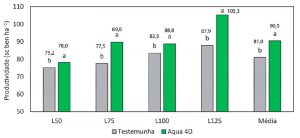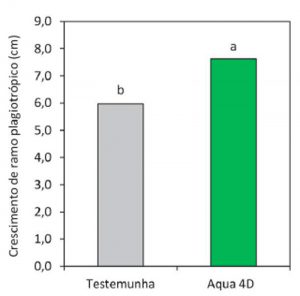The Benefits of Aqua4D treated water for Irrigated Coffee Cultivation
This article originally appeared in Portuguese in “Campo & Negocios”, September 2018
Coffee of excellent quality is now being produced in regions previously considered unsuitable due to water scarcity, such as Triângulo Mineiro e Alto Paranaíba in Minas Gerais, or Espírito Santo in the West of Bahia. However, the use of supplementary irrigation has proven to be advantageous during periods of water shortage, especially during critical growth phases.
January and February 2017 in Minas Gerais, for example, saw irregular and insufficient periods of rain, leading to reduced grain sizes and smaller yields. Meanwhile the region of Monte Carmelo has suffered from water shortages for several years, with low water levels in July and August especially making irrigation almost impossible.
Innovative irrigation solutions
Recent scientific studies have concluded that the treatment of irrigation water decreases the surface tension of water, due to the way the resonance fields reorganize the structure of water molecules. This effect also eliminates biofilm and clogging while facilitating the plant’s absorption of water, making it possible to save water without causing any damage to the coffee plant.
Considering the potential of this technology for not only coffee but many other plants, for not only saving water but also increasing yields through better absorption, a study was carried out at a coffee grower in Cerrado Mineiro.
Treatment of water by Aqua4D – Monte Carmelo (Minas Gerais)
The study was carried out between September 2016 and July 2018 in Monte Carmelo, at an altitude of 890m. The coffee grown as part of the study was Topázio MG 1190 with a spacing of 3.80 x 0.60m. The soil used was Argissolo Vermelho, made up of 45-65% clay (see photo below). The experiment was designed in randomized blocks, with 4 subdivided plots amongst a total of 32 plots, composed of 2 levels (normal water and AQUA4D® water). The water treatment modules were installed in the coffee plant’s irrigation system:
Results
The data obtained from 2016/17 and 2017/18 were submitted for statistical variance analysis, and when the effect of the treatments was significant, the averages were compared via Scott-Knott methodology (p< 0.05) with SISVAR software. In particular, the growth of the coffee crop’s plagiotropic branches was analyzed, showing that between December 2016 and May 2017 there was an increment of 21% (1.65) in the crops irrigated with AQUA4D® compared with the control.
Growth of plagiotropic branches, 16/17
Meanwhile, irrigation uniformity was evaluated, looking at the variability of water distribution along the irrigation system and the leakage of water from the drippers, which determines the system’s operating time. In the region of Cerrado Mineiro this is a significant point as the water obtained (from rivers, streams and lakes) is normally of a low quality, which increases the risk of blockages in the drippers.
Comparing the areas which received treated water with the control area, there was a significant increase in irrigation uniformity; the area treated by Aqua4D showed average uniformity above 96%, compared with 83.3% in the control area. Furthermore, the irrigation system in the untreated area showed a 9% reduced flowrate (2 litres per hour). Such conditions would require a longer run of the system to achieve the same result as the treated system.
Graphs: Uniformity and Flowrate
Water potential in the leaf as an indicator of hydric stress
In this variable, the lower the water potential in the leaf, the lower the stress of the crop. It can be observed that in periods of water deficiency in the region at times when the coffee crop required the most water, i.e. flowering phase, there were significant differences between the treated and untreated area. On average, there was a reduction of 23% in the water potential in the leaf.

Graph: water potential

Graph: Productivity
2017/18 harvest & conclusions
In terms of productivity, there was an increase in production in the area which had received treated irrigation water, an average of more than 10%, and an increase of 5.3 processed sacks per cultivated hectare. Based on the analysis of the two harvests which took place during the trial period, it can be concluded that:
- The treatment of irrigation water improves the performance of localized systems and optimizes uniformity.
- In critical periods of high water demand, plants which receive Aqua4D treated water show less hydric stress in the leaves.
- After two growing seasons, plants irrigated with AQUA4D®-treated water showed increases in productive branches, which reflects an increase in the coffee productivity and yields.








